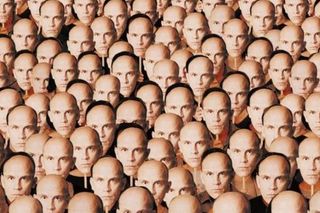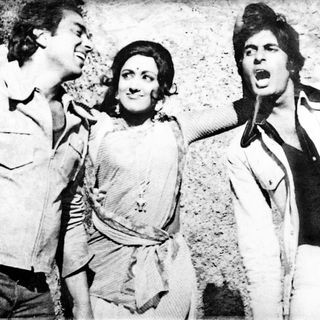
Where Is Male Baldness in Anti‑Beauty Norm Movements?
Historically, men have not been targets of corrective beauty treatments. Now, they are just like everyone else.

There’s been a beauty-related stigma existing in plain sight, one that has gone over our heads for the longest time — one our beauty positivity movements never even thought to address, let alone counter: male baldness.
Even more surprisingly, it’s Bollywood that has raised concerns over how we, as a society, view baldness in men, and why the stigma attached to being or going bald is debilitating. In Bala (2019), Ayushmann Khurrana — whose work my colleague Aditi Murti calls the “Akshay Kumar-esque social justice for the youths” — plays a miserable, insecure bald man, whose lack of hair is a running joke throughout the movie as he fields stigma from harmless teasing to disadvantaging discrimination from the people around him. Another 2019 film starring Sunny Singh and Maanvi Gagroo, Ujda Chaman (a remake of Kannada-language film Ondu Motteya Kathe), tackles similar stigma faced by balding men, albeit not very effectively.
These movies, released back-to-back in November, were a welcome respite from the comfortably scorned reality of baldness. While body positivity and body neutrality movements are trying to dismantle beauty norms that predominantly affect women, they have largely left out baldness — perhaps because it predominantly affects men, who, in history, have remained mostly unencumbered by societal expectations of beauty. In recent years, however, the male grooming market, aimed at helping men maintain (or regain) their confidence in their attractiveness, has been booming — it’s expected to be worth US$29.14 billion by 2024, according to Statista. Men are being asked to spend money, time, and energy caring about how they look and to be, arguably, more aware now than ever before of their appearance and how it does not conform to societal beauty standards — a majority of which have to do with hair.
The rest of us — mainly women — already have a framework in place to fight this type of pressure — social media campaigns, beauty positivity influencers, ‘woke’ corporations on board with the progressive beauty agenda. Why not include men, and their baldness, within?
*
Hair has always been a defining trait of masculinity — from the macho, hairy hunks of movies past to the clean-cut Hassan Minhaj-look of the present, a full head of hair and a groomed beard has been a physical staple of the good-looking man.
“Throughout the ages, a scalp adorned with luxurious hair has been assigned positive attributes of virility and power, whereas baldness has been associated with negative symbolisms,” writes Dr. Albert M. Kligman, MD, PhD, in “History of Baldness from Magic to Medicine.” “The Romans cut off the hair of prisoners, adulteresses, and traitors. The French shaved off the hair of women who were collaborators and mistresses of occupying Germans after France was liberated in World War II. Early Christianity endorsed the tonsure style to make monks sexually unattractive, thereby expressing humility and religious obedience.”
Related on The Swaddle:
Body Positivity is Excluding People; What if We Got Rid of Beauty Instead?
This perception stems from baldness’ association with aging (which has its own treasure of beauty stigma attached), Dr. David Fenton, of the British Association of Dermatologists, told BBC. “When you lose hair, one of the immediate messages is that you’re perhaps aging. And usually, this is something people don’t want. It goes along with superficiality and appearance in society.” In a youth-obsessed society, where being young is predominantly associated with vigor, dynamism, and energy, aging signifies the opposite — loss of energy, having passed the prime of life, and decreased levels of attractiveness and beauty.
Balding is not a disease; it’s a natural physiological process — caused by a combination of genes and the body’s response to testosterone — that 58% of men between ages 30 and 50, and 63.2% of men between 21 and 61, undergo, according to two population-based studies out of India. Yet, dermatologists, corporations, and Internet blogs constantly peddle all sorts of hair treatment options for the ‘affliction’ that is baldness — from the harvested fat from emus to expensive scalp injections designed to foster hair growth to elaborate home remedies that mix garlic, honey, tea, and raw eggs. Assuming they are effective, these are not even one-shot remedies; since baldness is a normal process, any treatment would need to be undertaken continuously throughout the course of a lifetime to maintain hair growth. Men, then, are falling prey to the same evils women have been battling forever — being coaxed into spending money for corrective beauty treatments that promise the world and deliver nothing but customer retention and steady profit for the corporation. They need the same beauty norm-fighting superheroes everybody else enjoys.
Especially because baldness-related stigma has detrimental effects on the men’s mental health: a 2005 study shows “hair plays an important role in determining self-image, social perceptions, and psychosocial functioning,” for men. Of the 1,536 men surveyed by researchers, 70% regarded hair as an important part of their image; 62% admitted hair loss affects their self-esteem; 43% said they felt less attractive after hair loss; 22% said baldness had negative effects on their social life; and 21% suffered from resulting feelings of depression.
Anti-beauty norm campaigns exist to fight these exact feelings — for women. And while body positivity and body neutrality have tackled aging by waging social media campaigns against products such as anti-aging creams and the celebrities who promote them, it has only been for women. Addressing age-related stigmatization of men in this already-existing framework will not be easy — most of the characteristics that older women are shamed for are celebrated in men, such as graying hair lending itself to the ‘silver fox’ characterization, or wrinkles making a man look ‘wise.’ There is a separate hair-related set of characteristics that wreak havoc on men’s self-esteem, which need to be identified and called out separately, even if the paradigm behind this effort is transferable.
Related on The Swaddle:
The Shame and Scandal of Indian Women’s Hair Follicles
Since beauty positivity movements already focus on women, fighting the stigma of baldness could be easier if it first tackles female baldness and then expands to include male baldness. Even this is not perfect; in women, a unique set of factors lead to baldness — for example, most women experience some hair loss after childbirth due to hormonal fluctuations. Birth control can also have debilitating effects on the quality and amount of hair, for similar reasons.
In all bodies, not eating enough protein, a compound responsible for the growth of hair, can also affect hair cells. Other factors include medications for blood pressure, some antidepressants and HIV medication, stress, sickle cell anemia or autoimmune conditions such as alopecia areata, lupus, arthritis, thyroid disease that are more common in women. These factors are not necessarily associated with aging, therefore, male baldness can neither be included in the women-specific, already-existing age positivity movement, nor can it be looped in with a potential baldness positivity movement — both of these experiences are very different between men and women.
*
This speaks to a larger problem in these anti-beauty norm movements — the truth is, they’re neither constructed nor equipped to be nearly as inclusive as they purport to be. The narrow umbrella under which a small set of beauty norms are challenged leaves no space to include fights against other, more complex beauty norms, such as baldness and men’s and other genders’ unique experiences with beauty norms.
Ultimately, the difficulty lies in separating men from the patriarchy that governs gender norms for all genders — albeit, women more stringently. If the exclusion of men from these movements is to somehow punish them for perpetuating the same beauty norms women fight against, fine — to each their own. But if the goal is complete, irreversible dismantling of beauty norms, then inclusivity is the answer.
Beauty standards may be gendered, but the fight to destroy them certainly shouldn’t be.
Rajvi Desai is The Swaddle's Culture Editor. After graduating from NYU as a Journalism and Politics major, she covered breaking news and politics in New York City, and dabbled in design and entertainment journalism. Back in the homeland, she's interested in tackling beauty, sports, politics and human rights in her gender-focused writing, while also co-managing The Swaddle Team's podcast, Respectfully Disagree.
Related


Woe Is Me! “I Love My Boyfriend, but His Brother Is Toxic. What Do I Do?”
